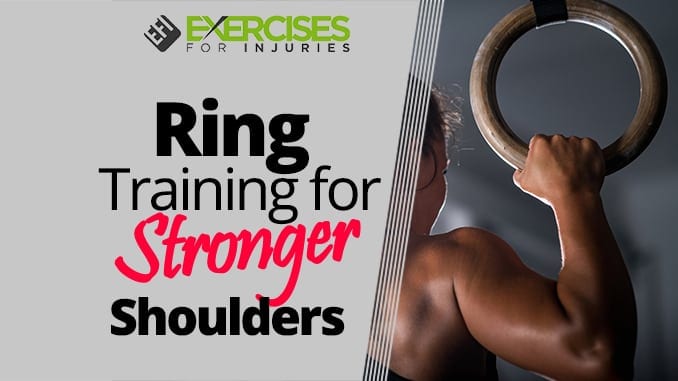Here is the ring training for strong shoulder [1] exercises to help you get stronger and build bigger traps and shoulders.
Over the weekend, I hosted Dan John. He did a two-day seminar on his training techniques. There were four sets of ring training at one of the gyms we were at.
It was great to see everyone play around with them like kids.
Here is Tyler with a few ideas on what you can do with the ring training.
Rick Kaselj
Hey guys, Tyler here from Garage Warrior, and this special video is for Rick Kaselj and everyone over at EFI.
Rick asked me to shoot a video on Ring Training, some of the things you can do with rings with your clients and yourself to improve your strength and stability.
Rings are one of the best tools that you can use to improve your strength and stability in your workouts and your client’s workouts.
I will teach you a simple, simple hold that you can do to build that strength [2] and stability.
Now, Why are Rings So Cool?
It is because they are unilateral, so you’ve got to stabilize two different portions at the same time, and they require full-body tension. If you try to use gymnastic rings without keeping your body completely tensed, then you will not get the results you want, and you cannot do the various exercises.
Generating the Core with Full-body Tension
Today, I will teach you how to generate that core with full-body tension and how you can use that in your workout and your clients’ workouts to get better results. I am going to teach you this basic exercise called ring support.
You need to come up in a support position. Have the rings just about hip height, and you need to lift your legs and keep everything tight. This is the foundation of doing super-advanced exercises like iron crosses and things like that. Believe it or not, this is much more challenging than it looks.
So How Will You Work Up With Your Clients In Doing This?
First of all, you have to teach them how to keep their arms locked into their body and fire all the muscles simultaneously. You can do that by bringing your arm down by your body. You can put your fingers underneath your wrist and lift it outward. Their whole goal is to keep their body down there.
This is one of the few exercises that use all the muscles in the upper body to pull the arm down to the side. In that position, you can test their pec muscle and see if it is firing. Then you can turn them on their back, test their lat muscle, and see if their lat muscle is firing.
And finally, you want to do so with a straight arm to avoid trying to use more of your biceps and those internal shoulder rotators. You also want to test and see if that triceps is firing to make everything locked out and straight.
Once they can do this in a solid position, you can have them work out to the rings instead of trying to deprive their hands. And what you want to do is have them or yourself hold your knuckles against your side-firing your triceps, your pecs, and your lats at the same time.
So here is what it looks like. Everything stays connected, and we hold it tight. Once you can hold that position for three sets of about 20 seconds, then you want to make it harder. You can see I am shaking just from that simple exercise.
Palms Out Position
You can make it harder by progressing into the Palms Out Position. Come up and stay stable, locking everything up and turning your palms outward. Shockingly difficult, very counting exercise. So start with just knuckles to the side and then slowly turn the palms out and maintain that full-body tightness you will learn from this exercise.
Again, once you can do about 20 seconds 3 times around holding that palm turned out the position, you can start to do more advanced skills.
I will show you one more variation where you do this without anything contacting the rings but your hands.
So with this one, come to the point where your palms are on the rings, and you will come knuckles to the side, and you get to the part where you can do this, where you can see just my hands are touching the rings and nothing else, very challenging.
It’s one of the few key progressions in being able to do very complicated things like the iron cross. So come up, palms flat on the rings this time. Turn your palms up and then bring it up to the point that it is just your hands on the rings. Hands towards the chest and get stable.
Conclusion
Now I know this seems very simple in terms of progressions, but adding this into an upper-body day or a core day, or at that end of your workout just for improving stability and control from your core out to your hands is a great way that you guys can do this in your exercise routines or your clients’ exercise routines.
I hope you enjoy this video on ring support and why you should be doing these three basic ring strength exercises. If you like this video, go ahead and click the button below and check out some of our other warrior programs. Thank you so much for watching.
Tyler Bramlett
1. Shoulder Strength and Range-Of-Motion Characteristics in… : The Journal of Strength & Conditioning Research. (2024). LWW. https://journals.lww.com/nsca-jscr/abstract/2002/08000/shoulder_strength_and_range_of_motion.6.aspx
2. Hayes, K., Walton, J. R., Szomor, Z. L., & Murrell, G. a. C. (2002). Reliability of 3 methods for assessing shoulder strength. Journal of Shoulder and Elbow Surgery, 11(1), 33–39. https://doi.org/10.1067/mse.2002.119852

